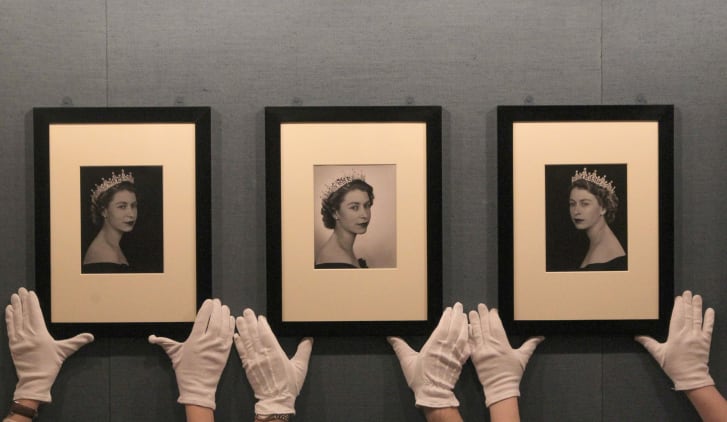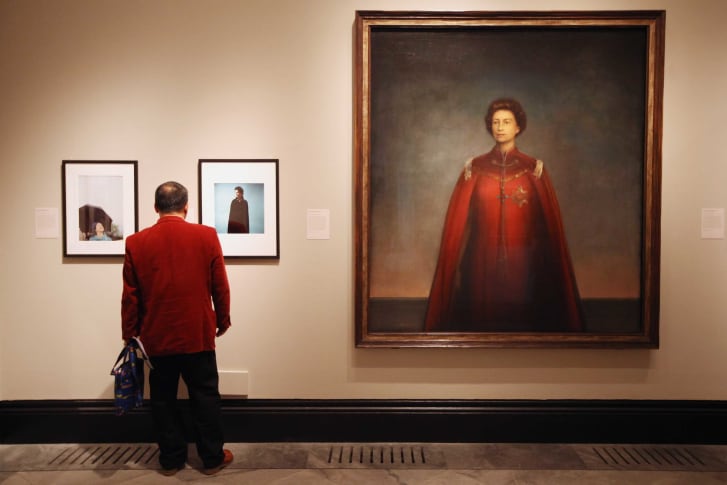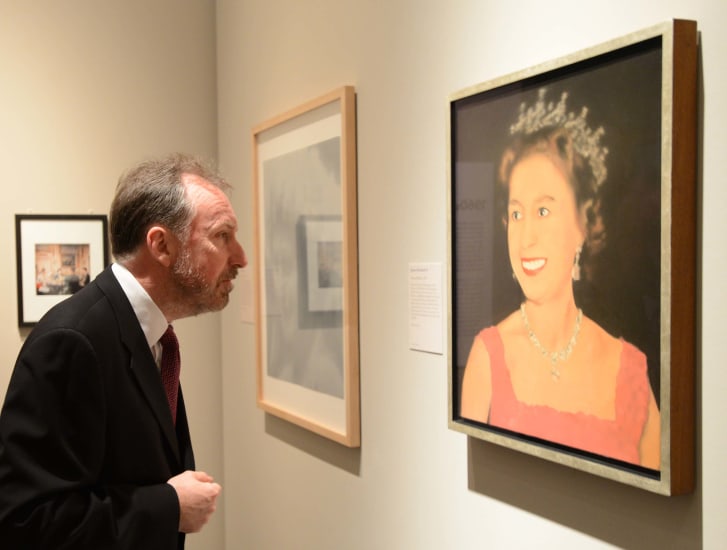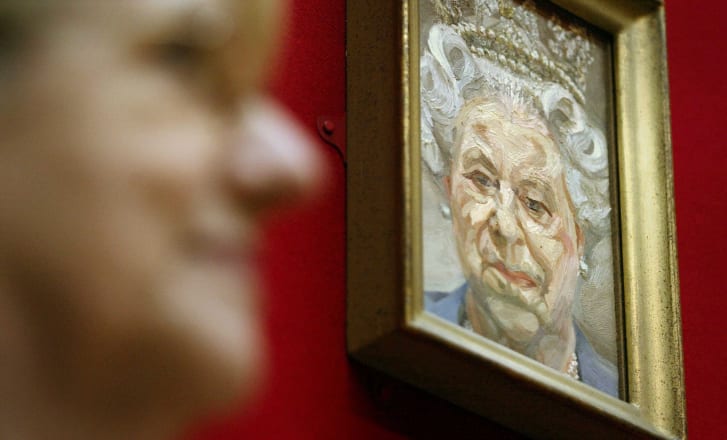It was one of those photogenic if historically insignificant moments when one (bona fide) icon fleetingly met another. Queen Elizabeth II met Marilyn Monroe at a London film premiere in 1956. The women probably had precious little in common aside from their age (both were then 30), global fame and glamour. A cameraman recorded the moment for posterity and, as luck would have it, Andy Warhol went on to make silkscreen prints of both women.
Warhol's silkscreen prints of Marilyn are among the first he ever published, executed in the months immediately after her death in 1962. His silkscreen prints of the Queen, however, are among his last and are less well-known. They were produced in 1985, as part of his "Reigning Queens" series, just two years before his own death.
With the Queen's silkscreen, Warhol was -- as always -- playing with the idea of celebrity and dissecting the relationship between subject and public persona. The image is based on an official photographic portrait taken in 1975, shortly before her 49th birthday. The Queen, wearing a tiara, is blue-eyed, regal and handsome, but also outlined and abstracted in blocks of color.
The image is artificial, seductive and memorable. The prints -- some of which were sprinkled with diamond dust, and were issued in different colors in sets of four -- came in a limited edition of 40. Better late than never, the Royal Collection Trust finally acquired a set for the Queen's Diamond Jubilee in 2012.

Photographs of Queen Elizabeth, taken by Dorothy Wilding in 1952, on display as part of 2012's "The Queen: Portraits of a Monach" exhibition at Windsor Castle. Credit: Steve Parsons/PA Images via Getty Images
In making screen prints of her, Warhol bequeathed us an image for art history and -- it could be argued -- of eternal regal glamour. As with Marilyn, we are left with Elizabeth as a Warhol icon. Just as Henry VIII was immortalized (huge, menacing, thick-necked, pasty-faced and piggy-eyed) by his court painter, Hans Holbein the Younger, might this prove to be a defining image of Elizabeth II half a millennium hence? Warhol evidently felt a celebrity kinship with his subject, once remarking that he wanted to be "as famous as the Queen of England."
As the British historian David Cannadine once noted, the Queen was "probably the most visually depicted and represented individual ever to have existed across the entire span of human history." She reigned for so long that we can only hazard a guess as to the number of images.
Propaganda images of Mao Zedong (who was also a Warhol subject between 1972 and 1973) were much disseminated during his lifetime, but he was always made to look the same: the benevolent founding father of the Chinese nation. With the Queen, however, the images vary in likeness and medium -- paintings, photographs, sculptures and holograms, as well that famously irreverent record cover for the Sex Pistols' 1977 single "God Save the Queen," where her eyes and mouth are obliterated by the names of the song and band.
The Queen never had a court painter as such. The nearest candidate was probably the Italian artist Pietro Annigoni, who painted a portrait of her between 1954 and 1955, and again in 1969. His first portrait of the young Queen particularly captured the public imagination. Framed against what could pass for an Italian Renaissance landscape and dressed in Garter robes, she gazes beyond us dreamily yet certainly.

"Queen Elizabeth II" by Pietro Annigoni was commissioned by the trustees of the National Portrait Gallery in 1969. Credit: Oli Scarff/Getty Images
The American photographer, Annie Leibowitz depicted her in a similar way half a century later, in 2007. Cloaked and solitary, the silver-haired matriarch looks straight down the camera's lens. By then, she'd got used to it all, having been endlessly photographed. She'd also been delivering Christmas messages on television since 1957.
During her reign, formal painted portraiture was largely superseded by photography. And at the outset, artifice ruled. The society photographer Dorothy Wilding, who took the accession photographs in 1952, focused on Elizabeth's youth and beauty, and had some prints hand-colored. Fashion photographer Cecil Beaton, who took the Coronation pictures in 1953 (and was practically court photographer in all but name), went further still. He promoted a fairytale vision, opting for theatrical backgrounds and some judicious retouching.
Later British photographers -- notably Antony Armstrong-Jones, the Earl of Snowdon and the Queen's former brother-in-law; and Patrick Lichfield, one of her cousins and the Earl of Lichfield -- went for informality and naturalism, and we got to know her a little better in the process. We were offered glimpses of the Queen and her family in domestic situations, at play as well as at work. Television crews began to be given unusual access for documentaries.

Society photographer Cecil Beaton, who took this photo of Queen Elizabeth with her maids of honor on her coronation day in 1953, captured many of the late monarch's most significant occasions. Credit: Print Collector/Hulton Archive/Getty Images
But perhaps the real revolution in our perception of the Queen came from members of the press -- and their telephoto lenses. They supplied some of the off-guard, more intimate walkabout moments. We got to see her reacting in shock to the Windsor Castle fire in 1992, solemnly and quietly inspecting the sea of floral tributes to Princess Diana outside the gates of Buckingham Palace in 1997, and shedding a tear at her sister's funeral in 2002. These images made her seem more human and sympathetic.
Two of the great (and most commercially successful) artists of the 20th century both tackled portraits of the Queen but in very different ways. In 1967, Gerhard Richter produced an oil painting based on a published photograph. (The year before, he had captured her in a lithograph.)

An observer takes a closer look at Gerhard Richter's 1967 painting of the Queen. Credit: Rune Hellestad/Corbis via Getty Images
As was the German artist's way, his image was faintly blurred, the colors and her features exaggerated. The Queen looks unreal, if not surreal. She's still recognizable but somehow creepily not herself; she appears uncomfortable, as if suppressing a nervous giggle. It's unclear why Richter painted her like this -- he never offered an explanation.
In 2000, Lucian Freud began painting the Queen. It wasn't a commission in a formal sense. The Queen's former private secretary (and friend of Freud's) Robert Fellowes, had pursued the idea for some years. It took much negotiation, but around the time of Fellowes' retirement in early 1999, Freud finally agreed to do a portrait.
The sittings were spread over many months, between May 2000 and December 2001. When they began, the artist was 77; the Queen was 74. The result, painted in heavy impasto, was tiny (just 9 by 6 inches) and predictably controversial. Freud's painterly forensic eye was unflinching.

Lucien Freud's painting of the Queen seemed the antithesis of earlier, romanticized depictions of the Queen. Credit: Sion Touhig/Getty Images
Freud had requested she wear the diadem crown, as seen in some of Wilding's photographs. The crown is worn at a slight angle. She is pensive, a little downcast, a little weary perhaps. She has seen and been through a lot. The painting was -- as many newspapers pointed out -- unflattering, the antithesis of Annigoni's dreamy 1950s portrait. Freud made a gift of the painting to the Royal Collection. The Queen never publicly commented on it.
Would it have been to Prince Philip's taste? Probably not. As an amateur painter himself, he knew precisely what he liked. His private collection includes a painting of the Queen on horseback at the Trooping the Color ceremony. It was painted by his friend, the post-impressionist English artist and royal favorite Edward Seago. In Grenadier Guards uniform (white feathered hat and red coat), the Queen looked simply and recognizably magnificent.
Top image: A print of Queen Elizabeth by Andy Warhol is adjusted by an employee of Bonhams Auctioneers.
